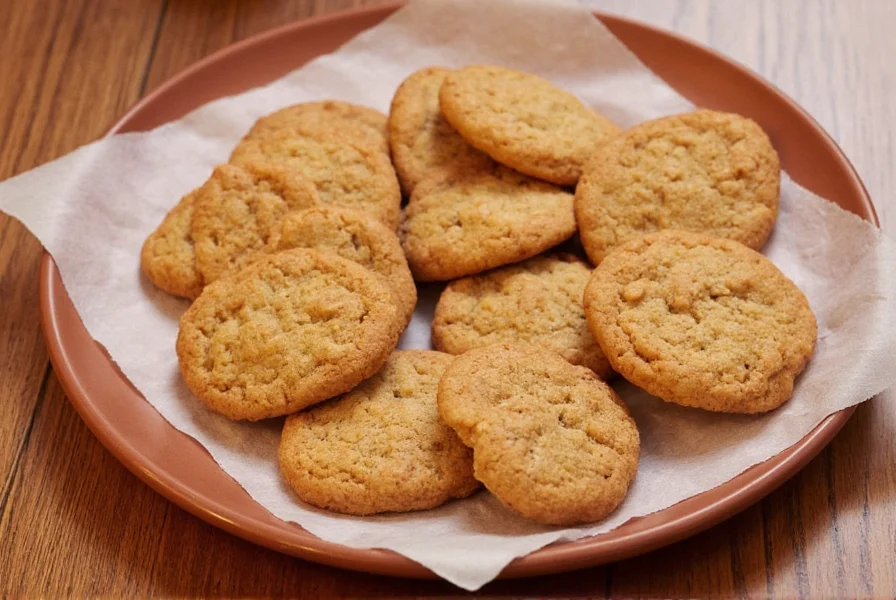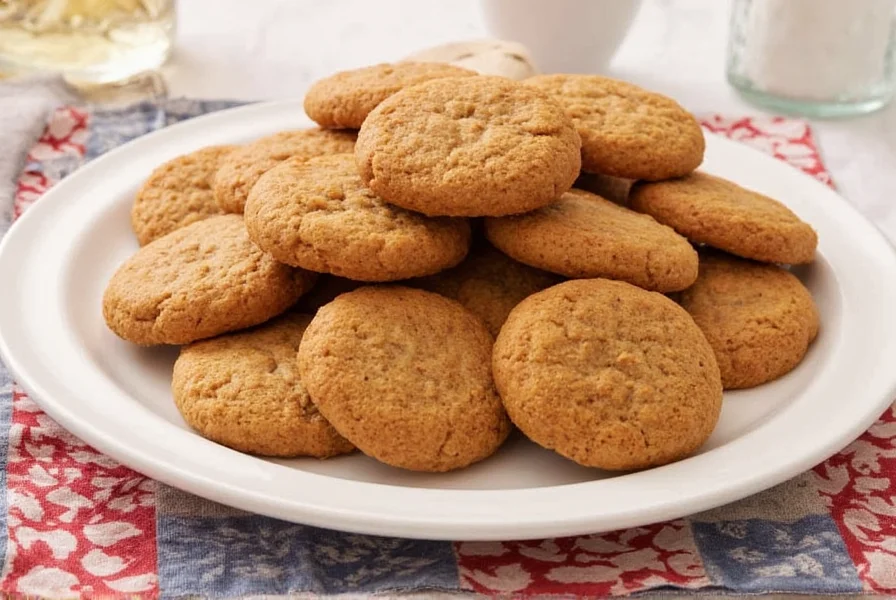Understanding the true origins of ginger snaps reveals a culinary tradition spanning centuries. These iconic spiced cookies didn't originate as the crisp, golden-brown treats many recognize today. Their story begins with medieval European spice trade routes that made ginger accessible beyond medicinal uses. Early versions were softer, cake-like biscuits called 'gingerbread,' evolving into the snap-style cookies we know when bakers discovered that reducing moisture content created that signature crisp texture.
The Historical Journey of Ginger Snaps
Ginger's journey to cookie dominance started in ancient times when Asian cultures used it medicinally. By the 11th century, European bakers incorporated ginger into honey-sweetened cakes. The term 'ginger snap' first appeared in American cookbooks around 1890, describing cookies that 'snapped' when broken due to their crisp texture. Traditional ginger snaps back the beginning relied on blackstrap molasses for depth, freshly grated ginger for potency, and creaming techniques that developed complex flavors through slow caramelization.
Authentic Ingredients in Traditional Ginger Snap Recipes
Modern commercial versions often substitute ingredients that compromise authenticity. True historical ginger snaps contain only:
| Traditional Ingredient | Modern Substitute | Flavor Impact |
|---|---|---|
| Blackstrap molasses | Light molasses | Loses robust, almost bitter complexity |
| Fresh grated ginger | Ginger powder | Diminishes bright, citrusy notes |
| Butter | Shortening | Reduces rich, nutty undertones |
| Hand-creamed batter | Machine mixing | Skips flavor-developing aeration |
These substitutions create what many consider 'ginger snaps back to the beginning' recipes—versions that honor historical preparation methods rather than contemporary conveniences. The most authentic recipes require 'bloomed' spices, where ginger and other spices steep in warm molasses overnight to maximize flavor extraction.

Traditional Ginger Snap Preparation Techniques
Mastering authentic ginger snaps requires understanding historical baking methods. Before modern ovens, bakers used residual heat in brick ovens, creating the perfect slow bake that developed complex Maillard reactions. Today's 'ginger snaps back the beginning' approach involves:
- Overnight resting - Allowing dough to rest develops flavor complexity through enzymatic reactions
- Hand-creaming butter and sugar - Creates air pockets that enhance texture without modern mixers
- Cast iron baking - Provides even heat distribution similar to historical baking surfaces
- Spice blooming - Steeping spices in warm molasses unlocks maximum flavor compounds
These techniques transform simple ingredients into cookies with layered flavor profiles—starting with bright ginger notes, evolving into warm spice complexity, and finishing with deep molasses richness. The most traditional recipes produce cookies that are crisp at the edges but slightly chewy in the center, creating that perfect 'snap' when broken.
Reviving Historical Ginger Snap Recipes Today
Modern bakers seeking authentic ginger snaps back the beginning should prioritize ingredient quality and technique over speed. Start with fresh ginger root rather than powder—grating it fine ensures even distribution without fibrous chunks. Use unsulfured blackstrap molasses for its robust flavor profile that light molasses can't match. The creaming process deserves patience; traditional recipes call for 10-15 minutes of hand mixing to properly incorporate air.
Temperature control proves crucial in historical ginger snap preparation. Unlike modern recipes that call for chilled dough, traditional methods use room-temperature dough that spreads slightly during baking, creating the characteristic thin, crisp texture. Baking on parchment paper rather than greased pans maintains authenticity while preventing sticking.

Why Traditional Methods Matter
Returning to ginger snaps back the beginning isn't just nostalgia—it's flavor science. Historical preparation methods developed through centuries of baking experience actually enhance the chemical reactions that create complex flavors. The slow creaming process develops emulsions that modern mixers can't replicate, while overnight resting allows enzymatic breakdown that intensifies spice flavors.
These traditional techniques create cookies with superior texture contrast—crisp enough to snap but with enough moisture retention to avoid becoming brittle. The flavor profile evolves as you eat, starting with bright ginger notes that mellow into warm spice complexity, finishing with deep molasses richness. This multidimensional experience separates authentic historical ginger snaps from modern commercial versions.
Implementing Authentic Ginger Snap Techniques
For bakers wanting to explore ginger snaps back the beginning, start with these practical steps:
- Source high-quality blackstrap molasses and fresh ginger root
- Allow all ingredients to reach room temperature before mixing
- Cream butter and sugar by hand for 10-15 minutes until light and fluffy
- Mix spices into warm molasses and let steep overnight
- Combine wet and dry ingredients gently to avoid overmixing
- Rest dough at room temperature for 2-4 hours (not chilled)
- Bake on parchment-lined baking sheets at 350°F until edges darken slightly
This approach requires more time and attention than modern recipes, but the results showcase why historical ginger snap techniques have endured. The cookies develop complex flavor layers impossible to achieve with shortcuts, creating an authentic taste of baking history.
Frequently Asked Questions
What makes traditional ginger snaps different from modern versions?
Traditional ginger snaps use blackstrap molasses instead of light molasses, fresh grated ginger rather than powder, and require hand-creaming techniques that develop complex flavors through slow aeration. They also typically rest at room temperature rather than being chilled, creating a distinctive crisp-yet-slightly-chewy texture that modern recipes often sacrifice for convenience.
Why do historical ginger snap recipes call for overnight resting?
Overnight resting allows enzymatic reactions to develop complex flavor compounds and helps the spices fully integrate with the molasses. This 'bloomed' spice technique, where spices steep in warm molasses, extracts maximum flavor compounds that wouldn't develop with quick mixing methods used in modern recipes.
Can I make authentic ginger snaps without special equipment?
Yes, traditional ginger snaps back the beginning were made with basic kitchen tools. You only need mixing bowls, a wooden spoon for creaming, measuring cups, and baking sheets. The key is patience during the creaming process and attention to ingredient quality rather than specialized equipment. Cast iron skillets can substitute for professional baking surfaces if needed.
How do I achieve the perfect 'snap' texture in traditional ginger snaps?
The perfect snap comes from precise moisture control. Traditional recipes use less fat and more molasses than modern versions, creating the right balance between crispness and slight chewiness. Baking until the edges darken slightly but the centers still look soft ensures they'll crisp perfectly as they cool. Room temperature dough (not chilled) spreads appropriately to create the thin, crisp structure that defines authentic ginger snaps.
Why do traditional ginger snap recipes use blackstrap molasses?
Blackstrap molasses contains deeper, more complex flavor compounds developed during sugar refining. Its robust, almost bitter notes balance the sweetness and enhance the ginger's spiciness, creating the multidimensional flavor profile characteristic of historical ginger snaps. Light molasses lacks these complex compounds, resulting in a one-dimensional sweetness that doesn't properly complement the spices.










 浙公网安备
33010002000092号
浙公网安备
33010002000092号 浙B2-20120091-4
浙B2-20120091-4